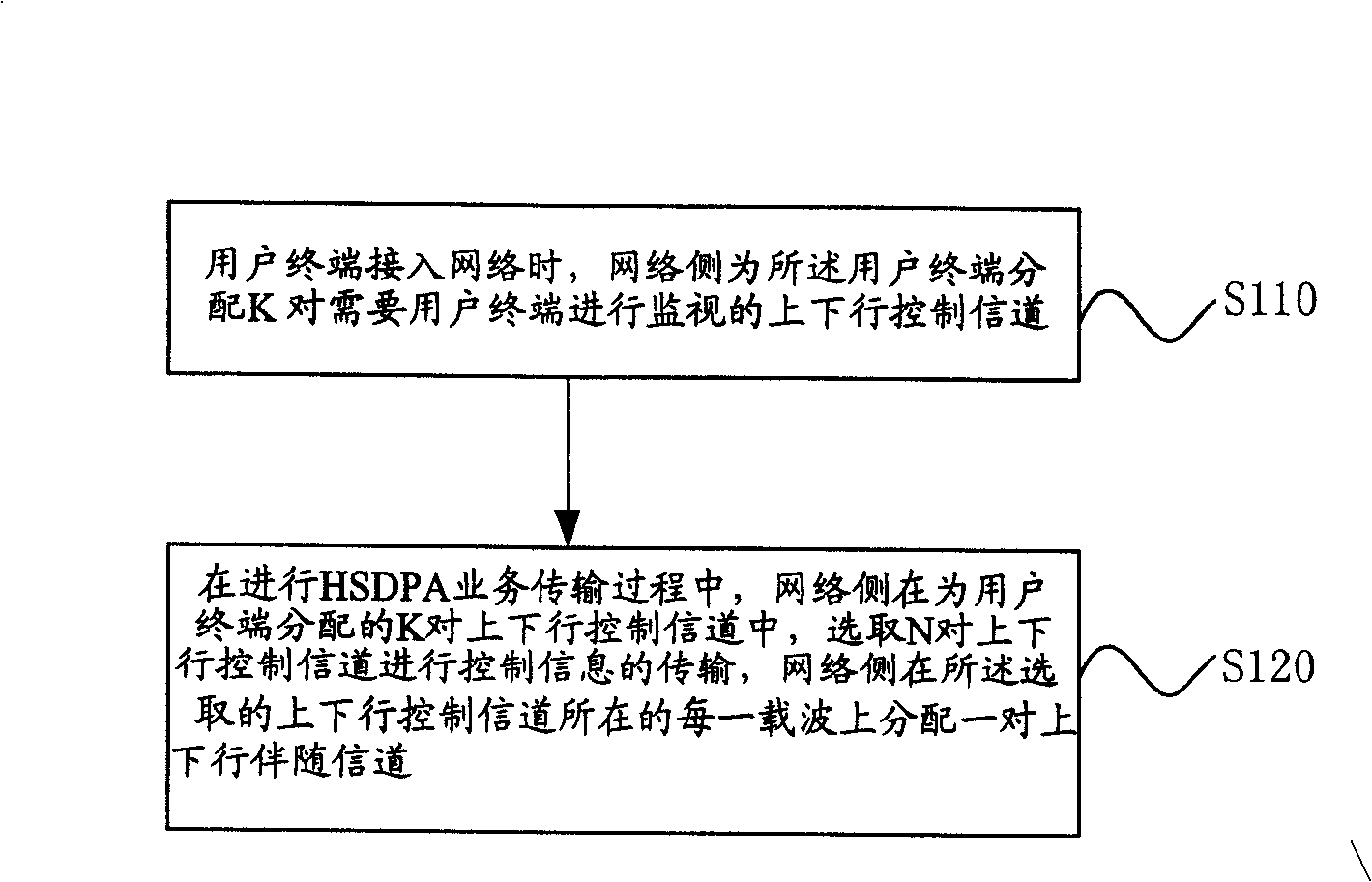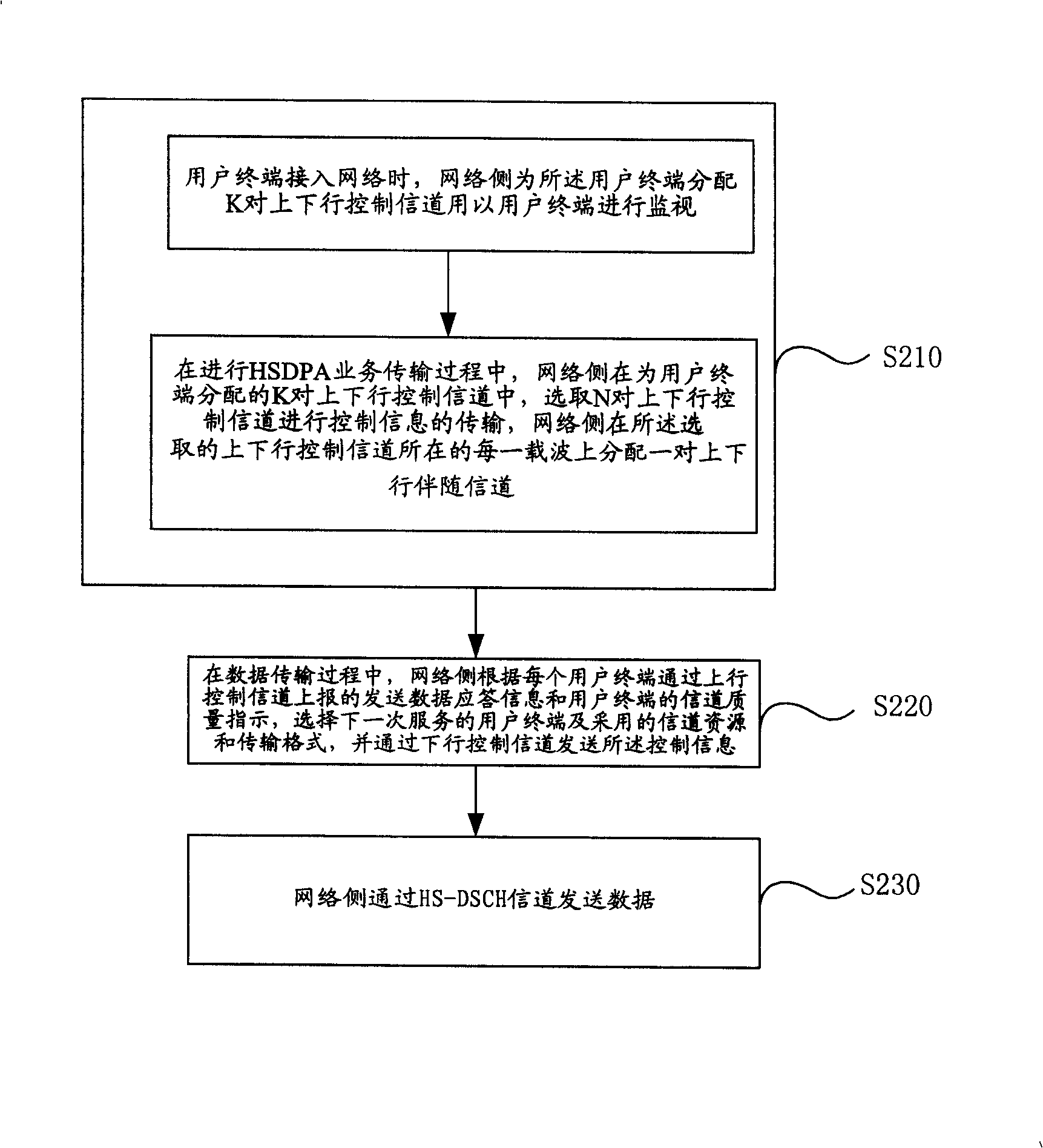Distribution method for multicarrier HSDPA control channel and transmitting method of grouped data
A technology for controlling channels and allocation methods, which is applied in the field of communication, can solve problems such as the inability to meet the control requirements of multi-carrier HSDPA, and achieve a simple effect
- Summary
- Abstract
- Description
- Claims
- Application Information
AI Technical Summary
Problems solved by technology
Method used
Image
Examples
Embodiment 1
[0043] When the user terminal accesses the network, the network side allocates K (K>=1) pairs of uplink and downlink control channels to the user terminal for monitoring by the user terminal. During the HSDPA service transmission process, the network side selects a pair of uplink and downlink control channels (HS-SCCH and HS-SICH) from the K pairs of uplink and downlink control channels for user terminals accessing the network. It transmits control information for packet data transmission on all carriers. The control information on the HS-SCCH channel includes the number of carriers and the corresponding frequency point, the time slot allocated to the user by each carrier, the code channel number, the modulation mode of the transmitted data, the size of the transmitted data block, and the redundancy version number , the retransmission identifier, the processing process of the HAQR, and the ID number of the UE. The user terminal can correctly receive the packet-switched data s...
Embodiment 2
[0046] During the HSDPA service transmission process, the corresponding relationship between each carrier and a selected pair of uplink and downlink control channels (HS-SCCH and HS-SICH) is established. The pair of uplink and downlink control channels may or may not be located on the corresponding carrier. Moreover, the uplink control channel and the paired downlink control channel may be located on the same carrier, or may be located on different carriers. The network side transmits the control information used for HSDPA transmission on each carrier for the user terminal through the pair of uplink and downlink control channels corresponding to the carrier, and uses the uplink and downlink accompanying channels to set up the uplink control channel and downlink control channel on the same carrier. initial power. That is, in the process of multi-carrier transmission, if the network side uses L carriers for packet data transmission, then the network side uses L pairs of uplink ...
example 1
[0071] Assuming that the UE supports receiving HSDPA data on N carriers, the network side selects channel resources of M (M≤N) carriers from the N carriers supported by the UE. The channel resources include carriers, time slots, and code channels. The network side allocates K pairs of HS-SCCH channels and HS-SICH channels to user A, and the paired HS-SCCH and HS-SICH channels are on the same carrier.
[0072] User A monitors the K HS-SCCH channels when there is no data transmission. If the network side needs to send data to user A on the HS-DSCH channel, the network side will select one of the K HS-SCCH channels as the HS-DSCH control channel, and send all HS-DSCH channel-related control information. And allocate a pair of uplink and downlink accompanying channels on the carrier.
[0073] Assuming that Node B uses L carriers to send data to user A at the same time, this HS-SCCH channel sends user A the control information of the HS-DSCH channel on L carriers, such as the num...
PUM
 Login to View More
Login to View More Abstract
Description
Claims
Application Information
 Login to View More
Login to View More - R&D
- Intellectual Property
- Life Sciences
- Materials
- Tech Scout
- Unparalleled Data Quality
- Higher Quality Content
- 60% Fewer Hallucinations
Browse by: Latest US Patents, China's latest patents, Technical Efficacy Thesaurus, Application Domain, Technology Topic, Popular Technical Reports.
© 2025 PatSnap. All rights reserved.Legal|Privacy policy|Modern Slavery Act Transparency Statement|Sitemap|About US| Contact US: help@patsnap.com


